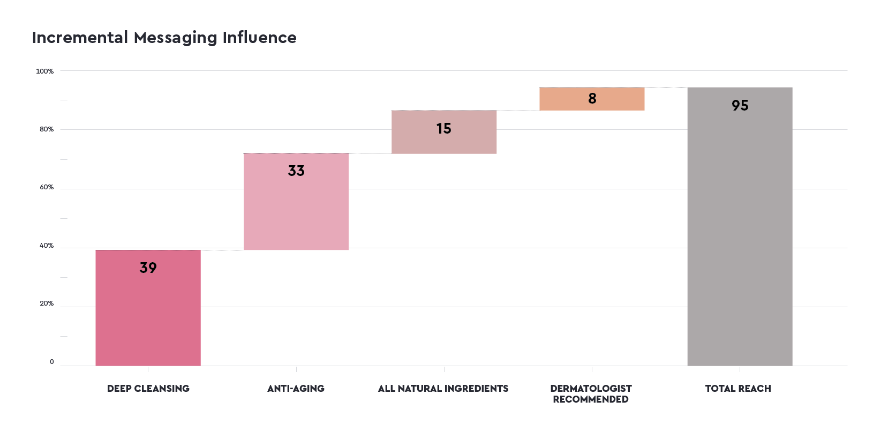How to perform TURF analysis
Below are the basics of running a TURF analysis for your business needs:
1. Identify your target market
This first step is crucial for any type of market research, including TURF analysis. You need to define exactly who you're trying to reach with your products or services. When identifying your target market, consider:
- Demographics: Characteristics such as age, gender, region, income level, education, occupation, or family status
- Psychographics: Qualities around consumers' lifestyle, interests, values, attitudes, and personality traits
- Buying behaviors: These are elements such as past purchases, shopping habits, or preferred channels (online vs. in-store)
- Needs and pain points: Consider defining your target market based on certain problems consumers might be facing? What are some unmet needs that your product/service would solve?
The more specific you are in defining your target market, the more accurate and useful your TURF analysis will be.
2. Create a list of features
This step is where you brainstorm all the possible features, attributes, or variations of your product or service. Think broadly and consider:
- Product details: Colors, sizes, flavors, scents, packaging options, and different levels of functionality
- Service options: Different service tiers, add-on features, delivery methods, and subscription models
- Marketing messages: Different value propositions, slogans, calls to action (CTAs), and creative approaches
Don't limit yourself at this stage – the goal is to generate a comprehensive list of possibilities, so the more you can brainstorm, the better.
3. Determine respondent preferences
At this stage, it's time to gather data from your target audience (the one you defined in step 2!). This typically involves a quantitative survey where respondents are presented with a subset of features and asked to indicate their preferences. quantilope's platform leverages a MaxDiff for this tradeoff exercise, where respondents will choose the most and least appealing options from a rotating set of choices, thereby determining relative preference.
4. Analyze the data
This is where the TURF algorithm comes in to analyze the collected survey data and calculate the reach and frequency for different combinations of features. A TURF output will show you the difference in reach and frequency as you add on additional features or elements (showing the respective increase for each incremental addition). The output also shows you how many respondents choose a certain combination of features as a whole, as well as how many choose that feature individually. Analyzing your TURF data helps you understand how different features contribute to overall appeal - and potential synergies between combination sets.
5. Identify the optimal combination
Based on your data analysis, you'll identify the combination of features that maximizes reach among your target audience. This is the sweet spot or 'optimal' combination; it's the set of offerings that will appeal to the largest possible audience by minimizing overlap. TURF analysis helps you avoid duplicating your efforts by reaching the same audience segments multiple times with different features. In other words, if adding a particular feature only reaches people who are already reached by another feature in your existing combination, it might not be the most efficient use of resources.
6. Take action
The final step in your TURF analysis process is to put your findings into action. This might involve:
- New product development: Use your TURF findings to refine your products and services or to generate new product offerings that focus on the most popular feature sets.
- Marketing & sales: Build your TURF insights into brand messaging and promotions, highlighting the key features that resonate most with your target audience.
- Resource allocation: Lean on TURF findings to guide investments into business areas that offer the greatest potential and reach.
Back to Table of Contents
Examples of TURF analysis in market research
Below are three examples of how businesses can leverage TURF analysis on quantilope's platform:
Beverage industry:
Let's say we're a beverage company and we want to introduce a new line of flavored sparkling water to the market. We drag & drop an automated TURF analysis into our study from quantilope's advanced method library to identify which flavor combinations will appeal to the largest number of customers. While in field, we monitor the results as respondents compete our survey, and we find that a combination of lemon-lime, strawberry-kiwi, and peach-mango flavors will provide the highest (unduplicated) reach among our target audience. Unduplicated means we aren't reaching the same consumers twice (i.e. the same consumer that wants lemon-lime also wants strawberry kiwi). We take these findings to our product development team to begin prototyping a new line of sparkling waters with these flavor profiles.
Beauty industry:
As another example, let's say we instead work in the beauty industry selling skincare products and we want to know which communication tactics reach the largest amount of potential consumers. We again drag & drop a TURF analysis for our skincare product messaging into our quantitative survey and find that a mixed-message approach mentioning 'deep-cleansing', 'anti-aging', 'all-natural ingredients', and 'dermatologist recommended' will reach 95% of our target audience. As a result, we launch a new campaign incorporating these messaging tactics into our commercials, magazine ads, and product packaging.
Snack industry:
As a final example, pretend this time that we're a snack company and we want to introduce a new variety pack of potato chips. First, we need to leverage a TURF analysis from quantilope's method library to determine which flavors of chips will be most appealing when combined together in one variety pack. The automated analysis shows that a combination of four flavors (Sour Cream & Onion, BBQ, Cheddar, and Black Pepper) will have the highest reach, so we drop the Salt & Vinegar and Jalapeño flavors from our variety pack planning.
Back to Table of Contents
When should I use TURF Analysis?
TURF is the perfect analysis choice for product or communication optimization. This includes:
-
Brand portfolio and product line planning
-
Which combination of brands or products will appeal to the greatest number of customers within your target audience?
- If you introduce a new SKU, will this cannibalize any variants within your existing product portfolio or will it attract new customers not previously reached?
- Within SKUs, which features should be included for maximum appeal?
-
-
Marketing and advertising campaigns
- Which mix of channels will enable you to reach the greatest number of people?
- Which are the most impactful creative routes and copy options?
-
Service planning
- Which combination of service features will achieve the greatest reach?
For example, imagine you have a range of yogurts and you're finding that the strawberry and raspberry flavors are doing well, while the apricot and cherry don't seem to be as popular. There will be a few issues you might want to consider before revamping your product line:
- Which people are buying strawberry yogurts, and which are buying raspberry? Are they completely separate sets of people?
- Who's buying apricot and cherry, and which other flavors do they enjoy? You might not want to lose your apricot and cherry lovers entirely if they're contributing enough to your market share...
- What might happen if you launch a mango variant?
- Which advertising channels will ensure the maximum number of people hear about your new product line?
Back to Table of Contents
What are the advantages of TURF?
TURF analysis' key strength, as we have seen, lies in identifying which possible combinations of items appeal to the greatest number of consumers. In the yogurt example, TURF would help avoid doubling up on product variants that appeal to the same people - so if all your strawberry lovers are happy to buy raspberry instead, you might decide to include one or the other in the range rather than both. The removal of apricot and cherry might mean you lose those customers altogether, so to keep them in your customer base you need to know which flavor they would buy instead. There might be a group of customers who prefer exotic fruit, and the introduction of a mango variant would bring in a whole new set of potential customers who would never consider buying strawberry or raspberry.
The most obvious advantage of TURF is that it doesn't just rank the flavors in order of preference, but tells you which combination of flavors will entice the biggest number of people to buy from your product line. A less sophisticated market research methodology - one that tells you strawberry and raspberry are by far the favorite flavors - might prompt the conclusion that both should be included in the range. But TURF goes further than this, showing the total unduplicated reach and frequency - that is, the percentage of people for whom at least one of the flavors is appealing, where preferences overlap, and the average number of appealing flavors per respondent. So you might well decide that strawberry, cherry, and mango is the ultimate line-up because that combination of products will have the best market potential. It will attract the greatest number of consumers and boost your market share.
Similarly, when it comes to marketing your new-look yogurt range, TURF can show you which combination of advertising channels will give it the greatest exposure. If a decent percentage of people are seeing yogurt adverts on both TV and social media, but another significant set of consumers is more open to advertising on the radio, you might choose to advertise via TV and radio only.
Other factors like pricing will be key to your final business decisions. However, understanding the optimal product line, service offer, or communication strategy will increase revenue, help to cut costs, and form valuable evidence to take to retailers when aiming to increase your share of shelf space.
Back to Table of Contents
Limitations of TURF research
TURF is an incredible research tool to leverage when planning out a set of product features or determining optimal reach for messaging and communication. However, like any research methodology or approach, there are some limitations to keep in mind:
Sample size:
TURF analysis does require a minimum sample size (typically a few hundred) to accurately represent your target audience. If your sample size is too small, or not representative, your results may not paint an accurate picture of the optimal set of features you're testing.
Scope:
TURF is great for measuring feature preferences (or some other combination of features) but it doesn't take into consideration other shopping influences like price, availability, or reputation. As such, consider using TURF findings alongside other research metrics before coming to a final product decision.
Back to Table of Contents
How to evaluate the results of the TURF Analysis
Evaluating the results of a TURF starts with reviewing each combination of the elements you tested in your analysis. A high reach overall suggests the potential for greater brand awareness and market penetration. However, don't solely focus on the largest number; just because you're reaching the most consumers with a certain combination of elements, doesn't guarantee you're reaching the right consumers. Identify which combinations maximize reach among your target audience and key consumer segments, considering factors like demographics, purchasing behavior, and media consumption habits.
Next, delve into the frequency of exposure generated by different channel combinations. While reach is important, repeated exposure can be crucial for message retention and driving conversion. Consider the optimal frequency for your target audience and product category. For instance, a high-frequency strategy might be necessary for a new product launch, while a lower frequency might suffice for established brands. Analyze how different combinations contribute to achieving this desired frequency.
Finally, interpret the results in the context of your overall marketing goals and budget constraints. For example, a combination of elements with slightly lower reach but significantly lower cost might be preferable if it aligns better with your budget and profitability targets. By considering reach, frequency, and budget constraints together, you can use your TURF analysis to make informed business decisions.
Back to Table of Contents
Can you conduct TURF Analysis in Excel?
Researchers can leverage Excel for a TURF analysis by using formulas such as COUNTIF and SUM to calculate reach and frequency for different combinations. However, as a TURF analysis grows in complexity (with more options and a larger respondent pool) accounting for audience overlap and unduplicated reach for numerous combinations becomes more difficult - increasing the risk of manual errors.
Automated market research platforms like quantilope offer a more streamlined and efficient approach for advanced methods like TURF. Automated platforms provide intuitive interfaces and algorithms for method setup, data input, data calculations, and data visualizations. Researchers leveraging these types of platforms can focus more on interpreting the results rather than getting bogged down in spreadsheets with complex formulas and calculations. While Excel can be a feasible option for basic TURF analysis, automated research platforms certainly offer a more robust and scalable solution, especially for larger or more intricate research needs.
Back to Table of Contents
How can quantilope help me with TURF?
quantilope makes it easy to set up a study and analyze the findings with TURF. The automated TURF survey design is based on a MaxDiff method: respondents are presented with combinations of products, brands, or features and asked to make trade-offs between them. After this, an automated & customizable real-time TURF simulator produces optimized options for maximum audience reach.
Check out how to create and analyze a TURF study here or watch this webinar to learn how product lines can be optimized using quantilope's automated TURF module.
For a great case study on the power of TURF, read about how quantilope's analysis helped understand behavior within the women's razor market so that shelf space could be used to drive optimal sales.
To learn more about quantilope's TURF methodology, get in touch below:






